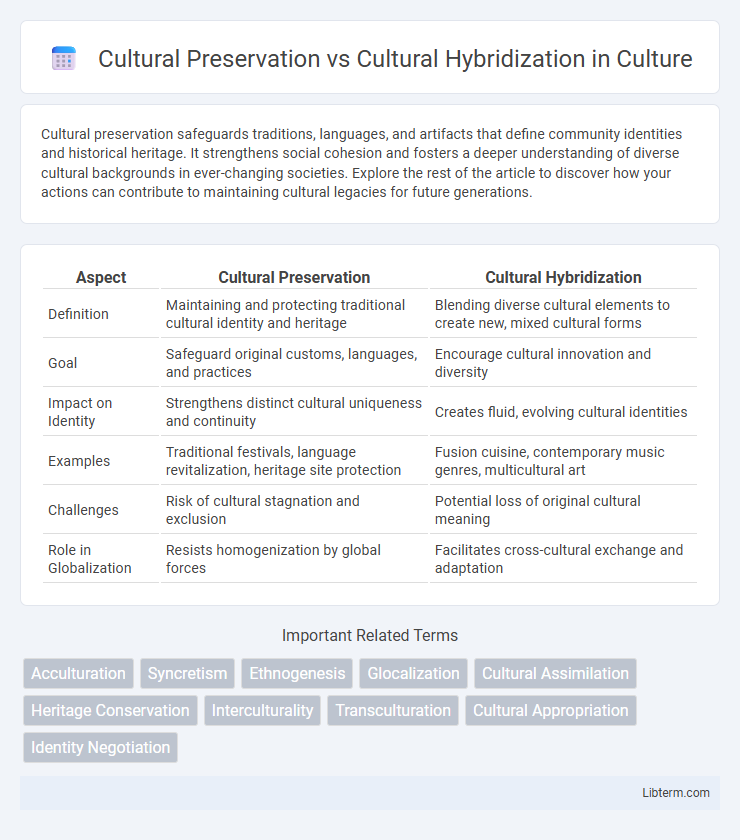Cultural preservation safeguards traditions, languages, and artifacts that define community identities and historical heritage. It strengthens social cohesion and fosters a deeper understanding of diverse cultural backgrounds in ever-changing societies. Explore the rest of the article to discover how your actions can contribute to maintaining cultural legacies for future generations.
Table of Comparison
| Aspect | Cultural Preservation | Cultural Hybridization |
|---|---|---|
| Definition | Maintaining and protecting traditional cultural identity and heritage | Blending diverse cultural elements to create new, mixed cultural forms |
| Goal | Safeguard original customs, languages, and practices | Encourage cultural innovation and diversity |
| Impact on Identity | Strengthens distinct cultural uniqueness and continuity | Creates fluid, evolving cultural identities |
| Examples | Traditional festivals, language revitalization, heritage site protection | Fusion cuisine, contemporary music genres, multicultural art |
| Challenges | Risk of cultural stagnation and exclusion | Potential loss of original cultural meaning |
| Role in Globalization | Resists homogenization by global forces | Facilitates cross-cultural exchange and adaptation |
Understanding Cultural Preservation: Definition and Importance
Cultural preservation refers to the practice of maintaining and protecting the customs, traditions, languages, and artifacts that define a community's heritage. It plays a crucial role in sustaining cultural identity, fostering a sense of belonging, and ensuring the transmission of historical knowledge to future generations. Efforts in cultural preservation support diversity and resilience by safeguarding unique cultural expressions in the face of globalization and cultural hybridization.
The Concept of Cultural Hybridization Explained
Cultural hybridization refers to the process by which distinct cultural elements blend to create new, dynamic cultural forms, reflecting globalization and increased intercultural contact. This concept emphasizes the fluidity and adaptability of cultures rather than their isolation, highlighting how traditions evolve through interaction with diverse influences. Unlike cultural preservation, which aims to maintain cultural heritage intact, cultural hybridization acknowledges the ongoing transformation and merging of cultural identities.
Historical Context: How Cultures Evolve and Interact
Cultural preservation maintains traditional customs, languages, and practices, ensuring historical continuity and identity within societies. Cultural hybridization emerges from intercultural contact, blending elements from different cultures to create new, dynamic expressions. Historical context reveals that cultures evolve through both preservation of heritage and interaction-driven innovation, shaping diverse social landscapes over time.
Benefits of Cultural Preservation in a Globalized World
Cultural preservation maintains the unique identities, traditions, and languages of communities, fostering a sense of belonging and continuity across generations. It safeguards indigenous knowledge and heritage from being eroded by global homogenization, promoting diversity in a rapidly interconnected world. Sustaining cultural heritage also supports local economies through tourism and crafts, enriching global cultural landscapes.
The Challenges Facing Traditional Cultures Today
Traditional cultures face significant challenges due to globalization-driven cultural hybridization, which often leads to the dilution of unique cultural identities and customs. Preservation efforts struggle against the influx of external influences, mass media, and technological advancements that promote homogenization over distinct cultural expressions. Protecting oral histories, indigenous languages, and ritualistic practices requires dedicated policies and community engagement to maintain cultural continuity amid rapid societal changes.
How Globalization Drives Cultural Hybridization
Globalization fuels cultural hybridization by enabling the rapid exchange of ideas, customs, and products across borders, leading to the blending of diverse traditions. Digital platforms, international trade, and migration intensify cross-cultural interactions, creating new hybrid identities and practices that reflect a synthesis of global influences. This dynamic process challenges traditional cultural preservation efforts by continuously reshaping local identities through global interconnectedness.
Case Studies: Successful Examples of Cultural Fusion
Case studies of successful cultural fusion highlight the dynamic interplay between cultural preservation and hybridization, such as the fusion of indigenous Maori traditions with contemporary New Zealand art forms, preserving heritage while fostering innovation. The culinary landscape of Peru exemplifies cultural hybridization through "Nikkei" cuisine, blending Japanese techniques with Peruvian ingredients to create globally acclaimed dishes that maintain cultural significance. In music, Afrobeat's emergence from traditional West African sounds combined with jazz and funk illustrates cultural preservation through adaptation, resulting in a vibrant genre celebrated worldwide.
Navigating Identity: The Individual’s Experience
Navigating identity amid cultural preservation and cultural hybridization involves balancing the maintenance of traditional values with the integration of diverse influences. Individuals often experience a dynamic tension as they selectively adopt elements from multiple cultures while striving to retain a core sense of heritage. This complex process shapes personal identity, fostering a unique blend of continuity and adaptation.
Balancing Preservation and Adaptation for Future Generations
Balancing cultural preservation and hybridization ensures the safeguarding of unique traditions while embracing the dynamic influence of globalization and innovation. Maintaining cultural heritage involves protecting languages, rituals, and art forms from extinction, yet adaptation allows cultures to evolve organically by integrating new elements that resonate with younger generations. Sustainable cultural development requires policies and community engagement that respect historical identity while fostering creative exchanges, securing cultural resilience for future generations.
Policy Approaches: Supporting Culture in an Interconnected World
Policy approaches to cultural preservation emphasize safeguarding intangible heritage, traditional practices, and languages through legal protections and community empowerment, ensuring cultural identities remain distinct amid globalization. In contrast, policies promoting cultural hybridization encourage intercultural dialogue, innovation, and the blending of cultural expressions to reflect an interconnected world's dynamic diversity. Effective frameworks balance heritage conservation with adaptive cultural exchange to foster sustainable cultural development and social cohesion.
Cultural Preservation Infographic

 libterm.com
libterm.com